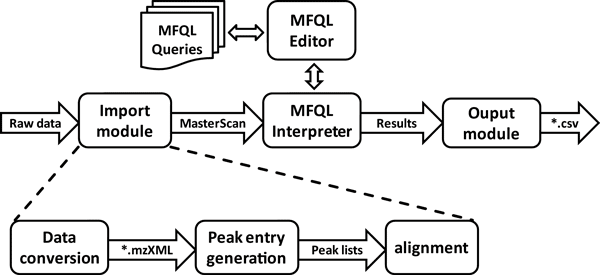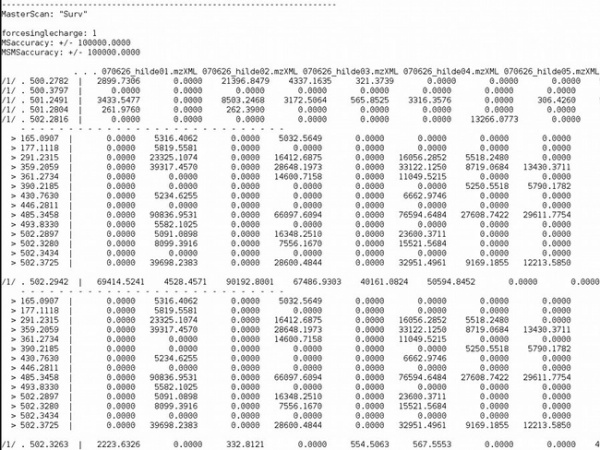Difference between revisions of "LipidXplorer Principles"
m (1 revision imported) |
|||
| Line 13: | Line 13: | ||
<br> | <br> | ||
| − | [[Image:MasterScan. | + | [[Image:MasterScan.jpg|center|600px|MasterScan]] |
<br> | <br> | ||
Latest revision as of 10:09, 1 March 2018
The Workflow of LipidXplorer
Shotgun MS and MS/MS spectra can be acquired at any mass spectrometer and submitted in *.mzXML file format. Alternatvely, the Import module can automatically convert files from *.raw (used by Thermo Fisher Scientific) or *.wiff (used by AB Sciex) to *.mzXML. Spectra are aligned and stored in the MasterScan, in which lipids are identified. The Molecular Fragmentation Query Language (MFQL) Interpreter applies user-defined lipid-class and / or lipid species specific queries to probe the MasterScan. The queries can be written using LipidXplorers integrated Editor. The identified lipids and intensities of user-defined reporter ions (molecular ions of intact precursors or of any specific fragments) are reported by the Output module as a *.csv file.
The MasterScan database
The MasterScan flat file database is built from all MS and MS/MS spectra acquired during the entire series of experiments, including all control samples and technical or biological replicas. The spectra are then aligned and MS/MS spectra associated to correspondent precursors and also aligned. Note that the database size is strongly reduced compared to the bulk of original raw spectra, because the MasterScan only stores the representative masses of aligned and merged peaks (but not each mass detected in each spectrum) (for details see [1]). However, peak intensities of each individual acquisition are preserved.
The MasterScan is schematically depicted here as file cabinet addressed at the top-level by the precursor masses (MS1) while intensities are assigned to each acquisition (Acquis.). In this example the precursor mass is m/z 788.55 and n samples are present. If MS2 experiments were acquired a list of fragment masses is linked to their precursor mass and intensities are assigned for each acquisition. In this example MS2 peaks of m/z 184.07, m/z 185.07 and m/z 788.55 are shown with their intensities for each acquisition (Acquis.).
Molecular Fragmentation Query Language
Query languages are computer languages used to make queries into databases and information systems (see [Wikipedia: Query language])
To the best of our knowledge, this is first application of a query language for identifying lipids in mass spectra. MFQL queries are defined by the user by formalizing compositional restrictions or fragmentation pathways known or assumed for lipids of any given class. Multiple reporter ions could be used for identifying species of a lipid class. The MasterScan can be probed by a virtually unlimited number of MFQL queries in parallel, while no dataset modification or change in the processing settings are required. Further details on the structure and syntax of MFQL is provided in LipidXplorer_MFQL.
References
[1] Herzog, R., Schwudke, D., Schuhmann, K., Sampaio, J.L., Bornstein, S.R., Schroeder, M., and Shevchenko, A. 2011. A novel informatics concept for high-throughput shotgun lipidomics based on the molecular fragmentation query language. Genome Biol 12(1): R8.

